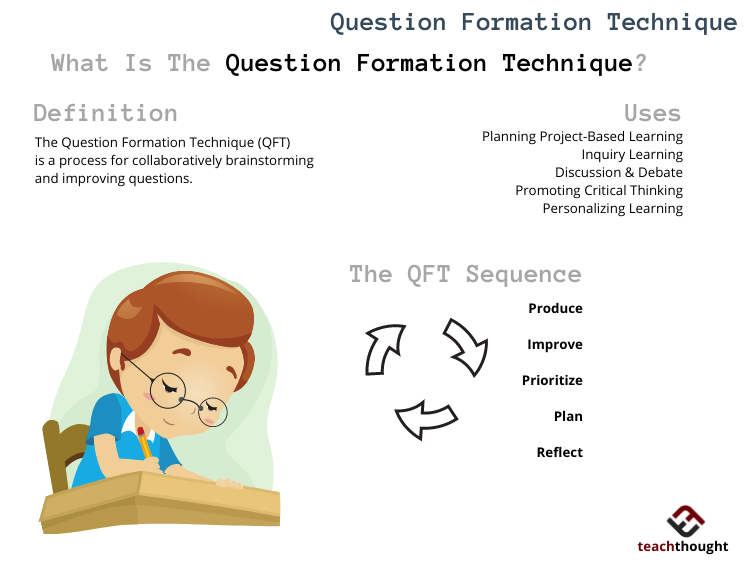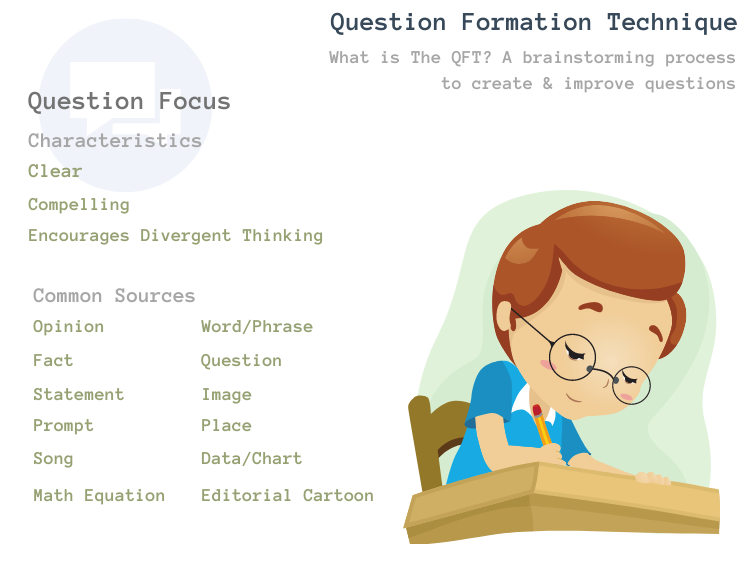
What Is The Question Formulation Technique?
by TeachThought Staff
Definition
Put simply, the Question Formulation Technique (QFT) is a process for brainstorming questions.
According to the creating organization, the QFT “helps all people create, work with, and use their own questions — building skills for lifelong learning, self-advocacy, and democratic action.” As a classroom tool for teaching and learning, the QFT is useful to promote inquiry, discussion, debate, project-based learning, and more.
The Parts Of The Question Formulation Technique
There are three primary parts of the QFT: the Rules, the QFocus, and the Sequence
The Question Formulation Technique Rules
These will be clarified more below in the ‘Sequence.’ But here are the four rules of the QFT:
1. Ask as many questions as you can.
2. Do not stop to discuss, judge, or answer the questions.
3. Write down every question exactly as it is stated. (This can be done by the teacher or a student, though I’ve had the most success letting students do it while I facilitated the session.)
4. Statements or ‘sentence fragments’ and other cognitive snippets are fine–just change any of these into questions at the end.
See also The Definition Of A Socratic Seminar
What Is The QFocus?
According to the Right Question Institute, the ‘QFocus’ is “a stimulus for jumpstarting questions. It is the focus of question formulation. The QFocus may be a statement, phrase, image, video, aural aid, math problem, equation, or anything else that gets the questions flowing. It may not be a question, and it should be related to the content or intended learning outcomes. A good QFocus should be simple and clear, and it should encourage divergent thinking.”

The QFT Sequence
This doesn’t always have to look exactly the same every time in every classroom, but generally, the sequence is reviewing the rules, clarifying the process, revealing the QFocus, and hosting the QFT itself.
The QFT process itself is Produce, Improve, Prioritize, Plan, and Reflect.
Produce
Summary: Brainstorm new questions–as many as possible without judgment–writing down everything that’s said exactly as it’s said, then changing any statements that were made into questions.
Time: ~5 mins
Improve
Summary: Categorize and label questions as Open or Closed, turn one Open question into a Closed question and vice-versa, then describe the advantages & disadvantages of both types of questions and their role in the inquiry process, then improve them (as necessary for clarity, precision, relevance, depth, etc.)
Time: ~5 to 10 mins
Prioritize
Summary: Select the ‘best’ three questions for your application
Time: ~5 mins (depending on experience level of teacher/class, how many statements need to be turned into questions, etc.)
Plan
Summary: Create a plan to use the questions for whatever inquiry/learning process relevant to your classroom application
Time: ~2 to 5 mins (depending on the nature of the plan/planning)
Reflect
Reflect on the QFT process, what you’ve learned, how your perspective has changed, etc.
Time: ~5 mins
(See the video below.)
See also What Is The Feynman Technique?
Clarifying Questions To Ask Students Before The QFT Process
Questions clarifying questions to ask before hosting a QFT: What is the purpose of the QFT in general? What is the purpose of our specific QFT today? Have I done this–or anything like it-in the past? How did it go? What might be difficult following the rules for producing questions? Which rule might be most difficult to follow? What is our question focus? What do I know/not know/think I might know about it?
This video is a nice short summary of QFT by InquirED.
